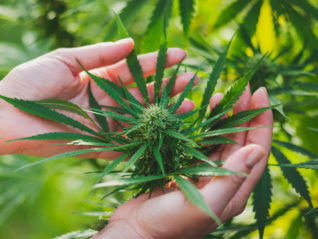
by Kari Hamrick, PhD, RD and Elnaz Karimian Azari, PhD
In school, we’re taught the human body is divided into 11 major organ systems that function together to carry out specific tasks. However, a new system has emerged in research over the last 30 years called the endocannabinoid system (ECS), which is described as, “one of the most important physiologic systems involved in establishing and maintaining human health.”1 This article aims to shed light on the size and scope of the ECS, its roles in the body, and strategies support your body’s internal homeostasis.
ECS at a glance
Endocannabinoids, our body’s own cannabinoids, and cannabinoid receptors are found throughout the body, including the brain, connective tissues, and immune cells.2 The ECS performs different tasks in each tissue, but the goal is always homeostasis. For example, when a stressful event occurs, the brain responds to coordinate and regulate a response. Preclinical evidence demonstrates that 1) the ECS helps modulate stress signals,3 and 2) the ECS helps regulate immune responses to prevent them from going haywire, thus relieving pain and inflammation.4
What is clinical endocannabinoid deficiency (CED)?
Everyone has an underlying “endocannabinoid tone.” Endocannabinoid tone describes the overall functioning of the ECS—the function or density of cannabinoid receptors, levels of endocannabinoids, and their metabolic enzymes.5 Dysregulation of the endocannabinoid tone, which is known as clinical endocannabinoid deficiency (CED), is implicated in various pathological conditions.6
One example of CED is the impact of posttraumatic stress on the ECS among survivors of the World Trade Center 9/11 attacks.7 Endocannabinoid levels were lower in victims with PTSD, suggesting they exhibited an inability to reset a healthy ECS tone and resume homeostasis after a traumatic event.7 CED has been linked with health conditions such as pain and psychiatric disturbances, with the greatest evidence present for migraines, fibromyalgia, and irritable bowel syndrome (IBS).5-6
Strategies to correct clinical endocannabinoid deficiency
Several strategies have been suggested to restore balance in CED and enhance the endocannabinoid functioning. Genetics, nutrition, lifestyle, and overall health status can impact endocannabinoid tone and functionality. Considering the wide range of systems the ECS helps regulate, supporting it and ensuring optimal function is important to overall health. The following outlines the “weeding, seeding, and feeding” of the ECS to provide targeted support to your body’s own homeostatic modulator.
WEEDING: Cleansing our lifestyle of ECS disruption
Stress
Stress is a stimulus that challenges our body’s homeostasis. Stress is inevitable in our lives and in some cases can be beneficial, such as for solving problems. However, both acute and chronic stress are a common cause of disruption to ECS tone, and animal models indicate that impairment in the ECS system may be involved in the development of stress-related mental health perturbations.3 Specifically asking patients about these topics, and emphasizing their importance may provide valuable encouragement to inspire change.
Numerous effective stress-reduction methods exist, including: meditation, yoga, acupuncture, massage, exercise, and social support. For example, a human trial of osteopathic manipulative treatment demonstrated increased endocannabinoid levels by 168% over pretreatment.8 Even dancing and emotional support, such as talking to friends and family, can benefit stress levels and significantly enhance ECS function.9
Pesticides and plastics
Certain endocrine-disrupting chemicals (EDCs) used in pesticides, such as chlorpyrifos and diazinon, alter normal ECS function.10 Therefore, choosing organic foods, especially when shopping for the highest pesticide-containing fruits and vegetables, as well as meat and dairy, should be considered. Plastic water bottles and food containers often have added chemicals called phthalates that have been shown to block cannabinoid receptors in animal models.11 Although food packaging is reviewed for safety by the FDA, it is prudent to check that items are specifically made for microwave and dishwasher use.
Alcohol
Some evidence suggests that chronic consumption of alcohol (in moderate to high quantities) can impair the ECS by increasing levels of endocannabinoids, which leads to the reduction of cannabinoid receptors’ expression and function.12 The downregulation of cannabinoid receptors in the brain is linked with tolerance to alcohol, and therefore, it is recommended to exercise moderation when drinking.13
SEEDING: Promoting healthy lifestyle factors
Dietary changes
There is increasing research indicating a dietary component in the modulation of the ECS. Endocannabinoids are products of dietary polyunsaturated fatty acids (PUFA), and cannabinoid receptor function can be modulated via modification of dietary fatty acid intake.14 A diet rich in omega-3 fatty acids has shown the potential to properly modulate the endocannabinoid signaling in dysregulated tissues such as liver and adipose tissue.15 In contrast, a diet that is high in omega-6 PUFA, such as a Western diet, causes overstimulation of ECS that ultimately decreases insulin sensitivity in muscle and promotes fat accumulation in the adipose tissue.16 Excellent dietary sources with a healthy omega-6:omega-3 fatty acid ratio (3:1) include coldwater fatty fish like salmon and tuna, krill oil, chia seeds, ground flax seeds or flax oil, walnuts, and hemp seeds. Supplementation with fish oil is also a practical way to address the widespread omega-3 gap.
Exercise
Aerobic exercise training results in weight loss and improved mood; it is also linked to higher endocannabinoid levels in healthy people.17 It is even thought that the “runner’s high,” a neurobiological phenomenon associated with exercise may be connected to the activation of the ECS.18 It is interesting to note that moderate intensity exercise (but not low or high intensity exercise) has significant impact on circulating endocannabinoids.18 Additionally, animal and human studies indicate that exercise that is forced or prescribed can be interpreted by the body as stress and result in a negative impact on ECS tone, whereas exercise that is self-selected is preferred and contributes to positive mood outcomes.19 It seems that when it comes to exercising to enhance ECS tone, if you are having fun, you are doing it right!
FEEDING: Endocannabinoid system enhancers
Although lifestyle modification is considered a first line therapy for most chronic disease management, for some individuals, targeted nutritional approaches can be utilized to support the ECS.
Probiotics and prebiotics
Many researchers believe that the ECS is the communication link between the gut and the brain that enables them to speak to each other.20 Researchers have demonstrated that probiotics, such as Lactobacillus acidophilus, modulate the ECS in the colon.21 Probiotic-rich foods include fermented items like yogurt, kefir, kombucha, and kimchi, and probiotic supplementation can provide one or more strains for targeted support. Additionally, preliminary studies demonstrate that prebiotics play a role in maintaining healthy intestinal ECS tone.22 This emerging area of research shows promise for regulation of inflammation and for treatment of abdominal pain and IBS.23
Herbs
Another approach is utilizing phytocannabinoids found in plants such as hemp. Cannabis sativa is an herb containing hundreds of bioactive compounds including phytocannabinoids and terpenes.24 The most well-known phytocannabinoids in cannabis are delta-9-tetrahydrocannabinol (Δ-9-THC) from the marijuana variety and cannabidiol (CBD) from the hemp variety. Both phytocannabinoids can confer health benefits, however, Δ-9-THC induces psychoactive effects while CBD does not. The mechanisms of Δ-9-THC extend beyond the scope of this article.
Cannabis extracts have metabolically active phytocannabinoids with biologic and therapeutic relevance as ECS enhancers.25 A review of evidence on the health effects of Cannabis extracts and cannabinoids determined that CBD has substantial evidence of effectiveness for conditions such as chronic pain, chemotherapy-induced nausea, and spasticity in multiple sclerosis (MS).26 Ongoing phytocannabinoid therapeutic research is promising.
While CBD has received the most attention, evidence suggests that whole-plant Cannabis extract that contains other phytocannabinoids, terpenes, and flavonoids is superior to isolated compounds from the plant.27 Terpenes are organic hydrocarbons found in the essential oils of plants that also act on cannabinoid receptors and neurotransmitters.28 Terpenes support synergistic actions of Cannabis-mediated pain, inflammation, and mood effects.28 You can find terpenes in citrus fruit rinds, mango, thyme, black pepper, and peppermint, to name just a few. In fact, over 100 terpenoid compounds are responsible for the unique aroma of Cannabis.29 Further, flavonoids, antioxidants found in many fruits and vegetables, exert additional synergistic effects by inhibiting the enzymes that break down endocannabinoids, thereby allowing them to prolong their therapeutic effects.30
As a result of negative attention on Cannabis, research expanded to isolating phytocannabinoids from other plants. One such plant is Echinacea, which has been shown to be safe and effective in the prevention of the common cold.31 Alkamides are the major lipophilic constituents of Echinacea angustifolia roots. The alkamides are structurally similar to endocannabinoids, and research suggests a selective affinity to cannabinoid receptors, which may explain at least part of their influence on immune response.32,33
Tea
The health advantages of tea have been known for thousands of years in the East. Catechins are bioactive phytonutrient compounds in tea that are thought to function as antioxidants, and accumulating research describes numerous potential benefits from reducing heart disease and cancer risk to facilitating weight loss efforts.34,35 We now understand that catechins also mimic endocannabinoids (cannabimimetic), so some of their health impact may be related to an effect on ECS tone.36 Catechins are found in high concentrations in green tea, but are also found in wine and dark chocolate.37
Conclusion
Since its discovery in the 1990s, the ECS has captivated the scientific community, and we are continually describing its extensive involvement in health. The growing body of knowledge paved the way for legalization of medical Cannabis, and is now helping us uncover lifestyle approaches to balance the ECS. A deficient ECS has significant health consequences, therefore the proposed “weed, seed, and feed” concept outlined in this article embraces the multifactorial nature of cultivating a healthy ECS.
References
- Alger BE. Getting high on the endocannabinoid system. Cerebrum. 2013;2013:14.
- Kruk-Slomka M et al. Endocannabinoid system: the direct and indirect involvement in the memory and learning processes-a short review. Mol Neurobiol. 2017;54(10):8332-8347.
- Qin Z et al. Chronic stress induces anxiety via an amygdalar intracellular cascade that impairs endocannabinoid signaling. Neuron. 2015;85(6):1319-1331.
- Barrie N et al. The endocannabinoid system in pain and inflammation: Its relevance to rheumatic disease. Eur J Rheumatol. 2017;4(3):210-218.
- Russo EB. Clinical endocannabinoid deficiency reconsidered: current research supports the theory in migraine, fibromyalgia, irritable bowel, and other treatment-resistant syndromes. Cannabis Cannabinoid Res. 2016;1(1):154-165.
- McPartland JM et al. Care and feeding of the endocannabinoid system: a systematic review of potential clinical interventions that upregulate the endocannabinoid system. PLoS One. 2014;9(3):e89566.
- Hill MN et al. Reductions in circulating endocannabinoid levels in individuals with post-traumatic stress disorder following exposure to the World Trade Center attacks. Psychoneuroendocrinology. 2013;38(12):2952-2961.
- McPartland JM et al. Cannabimimetic effects of osteopathic manipulative treatment. J Am Osteopath Assoc. 2005;105(6):283-291.
- Stone NL et al. An analysis of endocannabinoid concentrations and mood following singing and exercise in healthy volunteers. Front Behav Neurosci. 2018;12(269):1-10.
- Liu J et al. Comparative effects of parathion and chlorpyrifos on endocannabinoid and endocannabinoid-like lipid metabolites in rat striatum. Neurotoxicology. 2015;50:20-27.
- Forner-Piquer I et al. Dose-specific effects of di-isononyl phthalate on the endocannabinoid system and on liver of female zebrafish. Endocrinology. 2017;158(10):3462-3476.
- Pava MJ et al. A review of the interactions between alcohol and the endocannabinoid system: implications for alcohol dependence and future directions for research. Alcohol. 2012;46(3):185-204.
- Basavarajappa BS et al. Role of the endocannabinoid system in the development of tolerance to alcohol. Alcohol. 2005;40(1):15-24.
- Naughton SS et al. Fatty acid modulation of the endocannabinoid system and the effect on food intake and metabolism. Int J Endocrinol. 2013;2013(361895):1-11
- Banni S et al. Effect of dietary fat on endocannabinoids and related mediators: consequences on energy homeostasis, inflammation and mood. Mol Nutr Food Res. 2010;54(1):82-92.
- Kim J et al. Endocannabinoid signaling and energy metabolism: a target for dietary intervention. Nutrition. 2011;27(6):624-632.
- Dietrich A et al. Endocannabinoids and exercise. Br J Sports Med. 2004;38(5):536-541.
- Raichlen DA et al. Exercise-induced endocannabinoid signaling is modulated by intensity. Eur J Appl Physiol. 2013;113(4):869-875.
- Brellenthin AG et al. Endocannabinoid and mood responses to exercise in adults with varying activity levels. Med Sci Sports Exerc. 2017;49(8):1688-1696.
- Sharkey KA et al. The role of the endocannabinoid system in the brain-gut axis. Gastroenterology. 2016;151(2):252-266.
- Rousseaux C et al. Lactobacillus acidophilus modulates intestinal pain and induces opioid and cannabinoid receptors. Nat Med. 2007;13(1):35-37.
- Muccioli GG et al. The endocannabinoid system links gut microbiota to adipogenesis. Mol Syst Biol. 2010;6(392):1-15.
- Russo R et al. Gut-brain axis: role of lipids in the regulation of inflammation, pain and CNS diseases. Curr Med Chem. 2018;25(32):3930-3952.
- Turner SE et al. Molecular pharmacology of phytocannabinoids. Prog Chem Org Nat Prod. 2017;103:61-101.
- Di Marzo V et al. The endocannabinoid system and its modulation by phytocannabinoids. Neurotherapeutics. 2015;12(4):692-698.
- National Academy of Sciences. The Health Effects of Cannabis and Cannabinoids: The Current State of Evidence and Recommendations for Research. Washington, DC. 2017.
- McPartland JM et al. Cannabis and cannabis extracts. J Cannabis Therapeutics. 2001;1(3-4):103-132.
- Russo EB et al. Cannabis pharmacology: the usual suspects and a few promising leads. Adv Pharmacol. 2017;80:67-134.
- Turner CE et al. Constituents of cannabis sativa L. XVII. A review of the natural constituents. J Nat Prod. 1980;43(2):169-234.
- Chen AY et al. A review of the dietary flavonoid, kaempferol on human health and cancer chemoprevention. Food Chem. 2013;138(4):2099-2107.
- Ross SM. Echinacea purpurea: A proprietary extract of echinacea purpurea is shown to be safe and effective in the prevention of the common cold. Holist Nurs Pract. 2016;30(1):54-57.
- Woelkart K et al. The endocannabinoid system as a target for alkamides from Echinacea angustifolia roots. Planta Med. 2005;71(8):701-705.
- Sharma C et al. Small molecules from nature targeting G-protein coupled cannabinoid receptors: Potential leads for drug discovery and development. Evid Based Complement Alternat Med. 2015;2015(238482):1-26.
- Peluso I et al. Antioxidants from black and green tea: from dietary modulation of oxidative stress to pharmacological mechanisms. Br J Pharmacol. 2017;174(11):1195-1208.
- Rains TM et al. Antiobesity effects of green tea catechins: a mechanistic review. J Nutr Biochem. 2011;22(1):1-7.
- Korte G et al. Tea catechins’ affinity for human cannabinoid receptors. Phytomedicine. 2010;17(1):19-22.
- Gottumukkala RV et al. Determination of catechin and epicatechin content in chocolates by high-performance liquid chromatography. Int Sch Res Notices. 2014;2014(628196):1-5.
Kari Hamrick, PhD, RD is a registered dietitian with over 25 years of experience in nutrition and wellness and is the founder of Navigate Nutrition and Wellness, a private practice nutrition counseling center located in Gig Harbor, WA. Dr. Hamrick earned her PhD in nutritional sciences from Texas Woman’s University and received Adult Weight and Lifestyle Management certification from the Commission on Dietetic Registration. Kari has special training and experience in Mindfulness Based Eating Awareness Training (MB-EAT), women’s health issues, and the nutritional management of heart disease, eating disorders, and digestive health. Dr. Hamrick is currently completing a medical communication fellowship at Metagenics. Dr. Hamrick’s passion is helping individuals meet their nutrition and health goals with respect, open communication, and a sense of humor. She is also a yoga and dance instructor and enjoys learning and performing aerial acrobatic arts.
Elnaz Karimian Azari, PhD is Therapeutic Platform Lead for Cardiometabolic and Obesity platforms at Metagenics. She earned her PhD in Nutritional Physiology from ETH Zurich in Switzerland, studying the role of metabolic signals on eating and control of body weight. Elnaz completed her postdoctoral fellowship at the SBP Medical Discovery Institute, Center for Metabolic Origins of Disease (CMOD). Dr. Karimian Azari has acquired extensive theoretical and practical skills in nutritional physiology and metabolism with focus on the pathogenesis of metabolic disease induced by overconsumption of nutrients. She enjoys traveling, meeting new people, and exploring different cultures with her husband and daughter.





